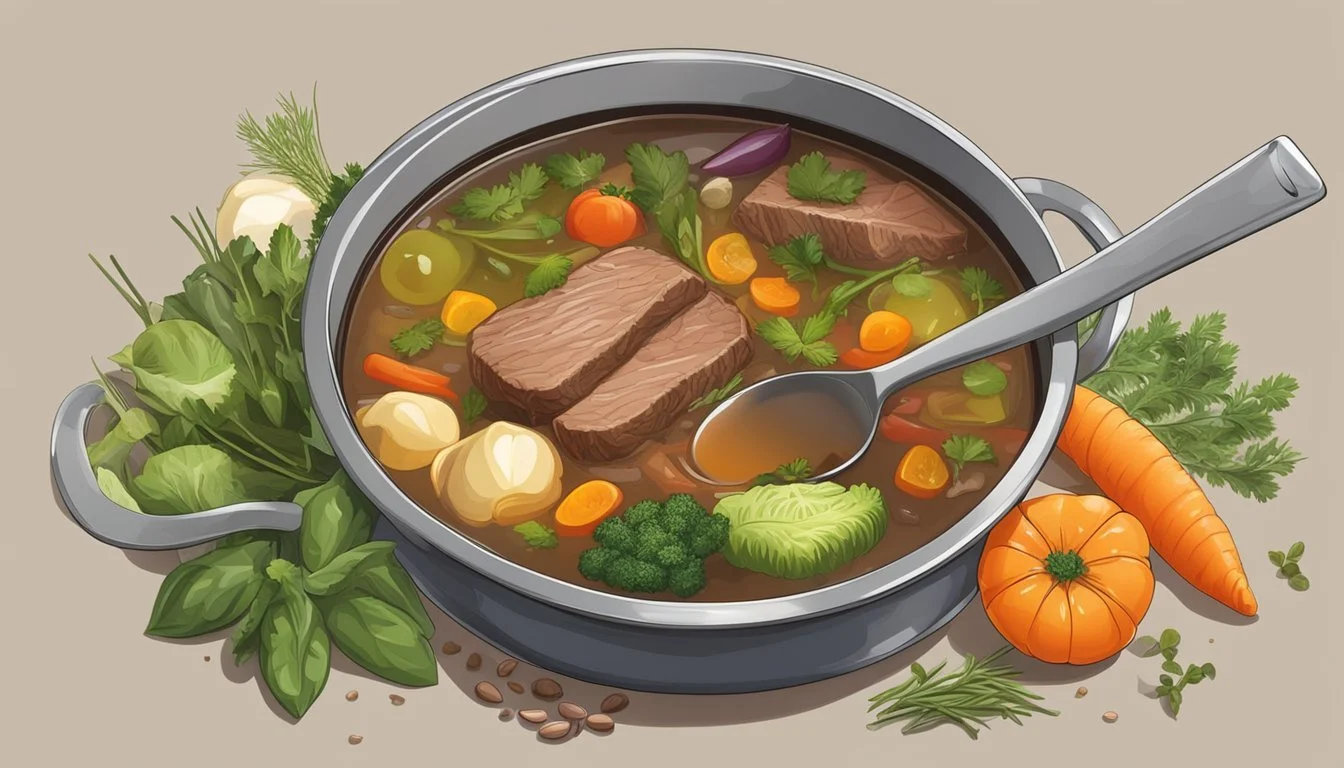Beef Broth Substitutes
Top Alternatives for Your Recipes
Beef (What wine goes well with beef?) broth serves as a cornerstone in numerous recipes, providing a rich, umami flavor that enriches gravies, soups, stews (What wine goes well with stews?), and sauces. However, there are various reasons one might seek substitutes for beef broth, ranging from dietary preferences to simple kitchen shortages. For those following vegetarian or vegan diets, replacing beef broth with a non-meat alternative is essential, yet even meat-eaters may need a substitute if they run out unexpectedly.
The market and home kitchens alike offer a plethora of viable beef broth substitutes, ensuring that flavor is not compromised when the original ingredient is not available. Beef stock can be an almost identical replacement, offering a similar flavor profile and consistency, with the main difference being the seasoning and the presence of meat in broth versus bones in stock. For a plant-based option, vegetable broth can step in, often made from simmered vegetables and water. It delivers a different yet pleasant flavor profile that can complement dishes traditionally made with beef broth.
Mushroom broth, with its savory depth, presents another exceptional alternative, especially for those who enjoy the earthy undertones that mushrooms (What wine goes well with mushrooms?) provide. This substitute not only aligns with vegetarian and vegan requirements but also satisfies meat-lovers with its robust flavor. In a pinch, pantry staples like soy sauce combined with umami boosters such as Worcestershire sauce or miso paste can be diluted with water to mimic the savory qualities of beef broth, showcasing the versatility of ingredients and the adaptability of recipes to different dietary needs and available supplies.
Understanding Beef Broth and Its Uses
Beef broth plays an integral role in enhancing the flavor profile of various dishes, imparting a meaty richness that is foundational in many recipes.
Key Characteristics of Beef Broth
Beef broth is a savory liquid made by simmering beef, usually with bones, vegetables, seasoning, and water over a prolonged period. It's seasoned to taste, aiming to infuse a subtle yet distinct umami flavor into dishes. The broth distinguishes itself from beef stock through its seasoning and a shorter cooking time, which yields a lighter texture and flavor suitable for soups and sauces.
Flavor Profile: Rich in umami and meaty flavors.
Color: Typically a clear to deep amber liquid.
Consistency: Generally thinner than stock due to less gelatin released from bones.
Common Culinary Applications
Chefs utilize beef broth primarily to elevate the taste of soups, stews, and sauces. It's a versatile liquid that can be used directly or diluted as needed to match recipe requirements.
Soups: Acts as a base, bringing together other ingredients with a coherent flavor.
Stews: Contributes to a rich, hearty base that highlights the main ingredients.
Sauces: Adds depth, enhancing both the body and taste.
Additionally, beef broth serves as a key component for deglazing pans to create flavorful gravies and can be used as a seasoning agent for an array of dishes, providing additional layers of flavor without overpowering the primary ingredients.
Popular Beef Broth Substitutes
When one needs to replace beef broth in a recipe, whether for dietary reasons or due to a lack of ingredients, there are several reliable alternatives that can provide similar flavor profiles or satisfy vegetarian and vegan preferences.
Vegetable Broth
Vegetable broth stands as a prominent vegetarian and vegan substitute for beef broth, bringing a complex array of flavors that can enhance a dish's overall taste. It commonly includes carrots, celery, onions, and herbs, mirroring the umami and savory notes desired in recipes calling for beef broth. It is particularly useful in soups, stews, and gravies.
Chicken Broth
For those who do not require a vegetarian substitute, chicken broth offers a close match to the richness of beef broth. While the taste may differ slightly, chicken broth can provide the necessary depth of flavor for most recipes. It typically contains similar seasonings and vegetables as beef broth, making it an effortless swap in cooking.
Mushroom Broth
Rich in umami, mushroom broth is a robust vegetarian and often vegan alternative to beef broth, supplying an earthy depth that is well-suited for many dishes. Mushrooms' inherent richness and meaty texture allow this broth to stand in for beef broth effectively, especially in risottos and sauces. It caters to meat lovers and vegetarians alike with its hearty undertones.
Making Substitutes Work in Recipes
When using beef broth substitutes in recipes, it's essential to account for both flavor and texture. One must adjust seasonings to attain the desired flavor profile and adapt the substitutes to mimic the texture of traditional beef broth.
Adjusting Seasonings for Flavor
The first step in using a beef broth substitute is to ensure the flavor intensity matches that of the original ingredient. Substitutes like red wine or soy sauce can be potent, and should therefore be diluted accordingly. For example:
Red Wine: For a balanced taste, combine ¼ cup of red wine with ¾ cup of water to replace 1 cup of beef broth.
Soy Sauce: Due to its richness, blend soy sauce with water or another broth at a 1:1 ratio for a more subtle flavor.
Careful seasoning is key to achieving an authentic taste. This involves tasting as one goes and incrementally adding salt or other spices until the desired flavoring is reached.
Adapting Substitutes for Texture
The texture of a broth can affect the body of gravies, casseroles, and other dishes requiring a liquid base. A beef broth substitute might need modification to attain a similar thickness. For a thicker consistency:
Thicken a watery substitute by simmering it with flour or cornstarch.
Utilize gelatin or pureed vegetables to add body without altering the flavor significantly.
A beef broth substitute's success in a recipe depends on how well it mimics the original's cooking properties. Substitutes should be chosen based on how closely they can replicate the base flavor and richness of beef broth, ensuring they integrate seamlessly into the dish.
DIY Beef Broth Alternatives
When one runs out of beef broth or prefers a plant-based option, they can easily rely on homemade alternatives that capture a similar richness and depth of flavor. Home cooks can utilize vegetables, aromatics, and herbs to create nourishing and flavorful substitutes.
Homemade Vegetable Stock
To create a homemade vegetable stock, one needs a variety of vegetables such as carrots, celery, and onions, which form the classic 'mirepoix' base. Here is a simple way to proceed:
Ingredients:
2 carrots, chopped
2 sticks of celery, chopped
1 large onion, chopped
1 tablespoon of vegetable oil or a pat of butter (for sautéing)
Optional: other vegetables (e.g., mushrooms for umami)
2 liters of water
Method:
In a large pot, heat the oil or butter over medium heat.
Add the chopped vegetables and sauté until they start to soften.
Cover with water and bring to a simmer.
Reduce heat and let simmer for at least 1 hour.
Strain the vegetables out, and the remaining liquid is your vegetable stock.
Creating Flavor with Aromatics and Herbs
Introducing aromatics and herbs like garlic, parsley, and bay leaves can significantly enhance the vegetable stock. Aromatic vegetables include:
Garlic: Adds depth and a hint of spice; crush a couple of cloves and add them to the pot.
Herbs:
Parsley: Delivers a fresh, grassy note; tie a bunch and include it during simmering.
Bay leaves: Contribute a subtle, herbal undertone; one or two leaves are sufficient.
Aromatics and herbs should be added to the pot along with the sautéed vegetables before covering with water. Remember to remove the herbs at the end of cooking to avoid overpowering the broth.
Condiments and Sauces as Flavor Enhancers
When cooking a recipe that calls for beef broth, certain condiments and sauces can provide the umami and depth of flavor typical of beef broth. The key is to use these substitutes in the correct ratios and to be aware of how their unique flavors complement the dish.
Worcestershire Sauce and Soy Sauce
Worcestershire Sauce: This condiment brings a complex flavor profile with its combination of vinegar, molasses, anchovies, (What wine goes well with anchovies?) garlic, tamarind extract, chili pepper extract, sugar, and salt. To enhance the taste of stews or soups, one can replace beef broth with worcestershire sauce diluted with water in a 1:3 ratio - one part worcestershire to three parts water.
Soy Sauce: With its salty and rich taste, soy sauce is a staple in adding depth to dishes. It contains soybeans, wheat, salt, and fermenting agents, which contribute to its umami quality. Replace beef broth with the same amount of soy sauce diluted in water to prevent the dish from becoming too salty.
More alternatives along these lines include:
Liquid Aminos: If soy allergies are a concern, liquid aminos serve as a gluten-free alternative to soy sauce. This condiment can also be used in a 1:1 ratio when substituting for beef broth.
Steak Sauce: Although not traditionally used as a broth substitute, steak sauce can be diluted to add a beefy flavor to dishes when necessary.
Tomato Paste and Red Wine
Tomato Paste: It offers a concentrated source of umami. To substitute for a cup of beef broth, mix one tablespoon of tomato paste with enough water to make one cup. They should be mindful that tomato paste can impart a distinct tomato flavor to the dish.
Red Wine: A rich, full-bodied red wine can add complexity and richness similar to beef broth. Use a ratio of 3:4 – three parts wine to four parts water – as a replacement in soups and stews.
Beer can also be considered in this context, branded as a flavorful liquid that imparts a malty character and tenderizes meats as well. An equal amount of beer can be used in place of beef broth, especially in robust dishes like chili or beef stew.
Specialty Substitutes for Dietary Needs
In catering to dietary restrictions, specialty substitutes for beef broth must consider sodium content, gluten presence, and alignment with vegetarian and vegan lifestyles. The market offers several alternatives that provide flavor while aligning with health-conscious and allergen-free diets.
Low-Sodium and Gluten-Free Options
Consumers looking for low-sodium and gluten-free alternatives to beef broth have multiple options available. One can opt for homemade beef stock, using less salt or salt substitutes for a low-sodium version. Additionally, there are commercially available beef broth substitutes labeled as "low-sodium" that significantly reduce salt content.
For those with gluten sensitivities, careful label reading is crucial as some broths contain gluten. Gluten-free broths typically use rice flour or cornstarch as thickeners instead of wheat-based products. Here's a brief overview in table format:
Substitute Low-Sodium Gluten-Free Notes Homemade Beef Stock ✔ Depends on Recipe Control ingredients to manage sodium and gluten content. Commercial Low-Sodium Broth ✔ Check Label Pre-made options are convenient but verify ingredients for gluten. Branded Gluten-Free Broth Check Label ✔ Specifically designed to be safe for those with gluten intolerances.
Plant-Based and Allergen-Free Broths
For vegetarians and vegans, plant-based broths serve as the perfect substitute. These broths are often made from simmering vegetables, herbs, and spices and are naturally free of common allergens found in meat-based broths. They come packed with health benefits due to the incorporation of natural, wholesome ingredients.
Allergen-free broths should exclude major allergens such as dairy, eggs, soy, nuts, and of course, meat. Labels such as "certified vegan" or "plant-based" often indicate a product free from these common allergens, but consumers should still review ingredient lists for any hidden sources. Consider the following options:
Vegetable Broth: A staple for those avoiding meat and allergens; rich in flavors and adaptable to personal taste preferences.
Mushroom Broth: Offers a rich umami quality, mimicking the depth found in beef broth, perfect for both vegetarians and vegans.
By focusing on these specialty substitutes, individuals can meet their dietary needs without compromising on flavor and quality.
Understanding Broth, Stock, and Consommé
In this section, you will learn the distinct characteristics of broth, stock, and consommé, each with its unique preparation method and culinary uses. Specifically, the differences between broth and stock and the role of consommé in cooking will be clarified.
Differences Between Broth and Stock
Broth and stock are both flavorful liquids used in making an array of dishes, but they differ in ingredients and their method of preparation. Broth is typically made by simmering meat, which may or may not include bones, in water, often with vegetables and herbs. The key goal is to extract flavor from the meat itself. Broth is usually lighter, both in body and flavor as it's cooked for a shorter time, and the use of meat is more pronounced than bones.
In contrast, stock is primarily derived from simmering bones for an extended period, which can range from 4 to 6 hours. This process extracts collagen from the bones, turning into gelatin once cooled, which gives stock a fuller mouthfeel or richer body than broth. Beef bones, chicken bones, or even fish bones can be used. Vegetables are also commonly added, but the emphasis is on the gelatinous quality that bones provide.
The Role of Consommé
Consommé is a refined and clear soup made from a concentrated stock or broth that has been clarified. A consommé is typically produced using a mixture, including beef bone broth or chicken stock, combined with a clarification mix made of egg whites and lean ground meat. The clarification process removes fat and impurities, resulting in a clear and elegant liquid. Beef consommé specifically is known for its concentrated flavor and is often served on its own as an appetizer or used as a base for more sophisticated sauces and soups.
Mushroom stock can act as a vegetarian substitute for consommé, providing a similar umami quality without the use of meat products. Mushroom stock involves simmering mushrooms along with vegetables to achieve a profound depth of flavor. It's appreciated in meat-free diets and can be used much like traditional stocks or consommés in various recipes.
Nutritional Information
When considering beef broth substitutes, it's important to examine their nutritional content, particularly in terms of calories, macronutrients, vitamins, and minerals. This can affect not only the flavor of a dish but also its healthfulness.
Caloric and Macronutrient Profile
Beef broth typically has a low calorie content; however, its substitutes can vary in caloric density. For example:
Beef Stock: Often has a similar calorie content to beef broth, with only a few calories per cup and minimal fat.
Chicken Broth: Comparable to beef broth, containing roughly 10-20 calories per cup with low fat and moderate protein.
Vegetable Broth: Usually low in calories but may provide a small amount of carbohydrates and fiber.
Mushroom Broth: Similar to vegetable broth, with slightly more umami flavor, and a negligible amount of carbohydrates and fiber.
Macronutrients like protein can also differ. While beef broth offers a modest amount of protein (around 2-3 grams per cup), vegetable broths often contain less protein, unless legumes or other protein-rich vegetables are used in their preparation.
Vitamins and Minerals in Broth
Mineral content such as iron and calcium is present in both beef broth and many of its substitutes, though levels can vary. Here's a brief outline of the nutrients found in some common substitutes:
Iron: Animal-based broths, like chicken, typically contain iron, though usually in lower quantities than beef broth.
Calcium: Often added to commercial broths and stocks for fortification, including vegetable broths.
Vitamins: Beef broth contains B vitamins, especially B12, vital for energy production, which may not be as prevalent in plant-based substitutes.
Amino acids, which are the building blocks of proteins, are found in both meat-based and plant-based broths. Meat broths generally provide a complete set of amino acids, whereas vegetable broths may lack one or more, but can still contribute beneficial amino acids when combined with other plant foods.
Cooking Techniques and Uses Beyond Soups
Beef broth substitutes are versatile, serving as the foundation for numerous recipes outside of the customary soups and stews. They enhance flavor and texture, providing depth to a variety of dishes.
Deglazing and Sauces
When deglazing a pan, cooks often use beef broth to lift the caramelized bits from the bottom, infusing sauces with rich, complex flavors. In cases where beef broth is unavailable, they might opt for alternatives like mushroom broth to maintain a hearty taste. This technique is essential in French cuisine and is used to create the base for classic sauces, such as the revered French onion soup.
Rice, Grains, and Stuffing
Using beef broth substitutes in cooking rice or grains imparts a savory quality that water alone cannot. Cooks may utilize vegetable broth or mushroom broth as a 1:1 replacement to infuse dishes with robust flavors. Similarly, when preparing stuffing, substitutes like these can moisten and enrich the filling, elevating a traditional side to new savory heights.





